Entries tagged with “Dyeing”.
Did you find what you wanted?
Mon 9 Apr 2012
As we get closer and closer to the fiber festival, it’s time to stop and take stock of the dyeing. I finally banded up all the braids last night, and then laid them all out to see the colors. The bottom row is polwarth, then falkland, then BFL, rambouillet, and shetland.
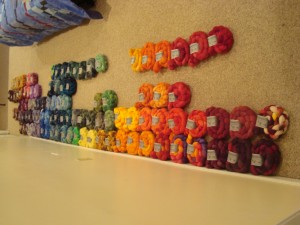
These are mostly semisolid colors, with just a few gradients and multi-color braids thrown in here and there. Next, I’ll be turning my attention back to the real painted fibers with multiple colors, but first I wanted to get a sense of where things stood.
In general, the color distribution looks pretty good. Lots of blue-greens and purples (no surprise there), a few browns, a surprising number of orange. Not much in the true/dark reds, the true blues, or the bright greens and yellows, so those are places to maybe make some more. Also, a few real pinks couldn’t hurt.
We also finished another project for the show this weekend. We’ve been looking and looking for ways of displaying items, and haven’t found much that was a) attractive b) portable and c) relatively inexpensive. So, we made something.
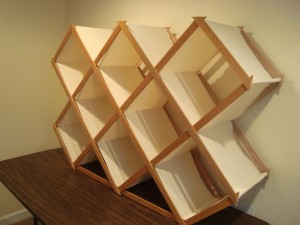
I bought some canvas at Joann’s using one of their 50% off coupons. On Friday, I pulled out my trusty sewing machine and set to work. First, I cut the fabric into strips and sewed the strips together to make pockets. Then, Branden cut and assembled the frame over the weekend. We’re both really pleased with how this came out. I am thinking that it may become a permanent addition to my fiber room after the show. (I’m also thinking I might need a few more…)
Of course, I like it even better when it’s full of fiber.
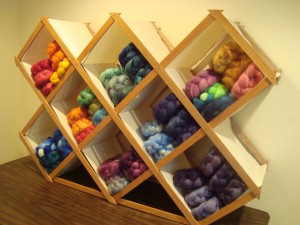
And the best part?
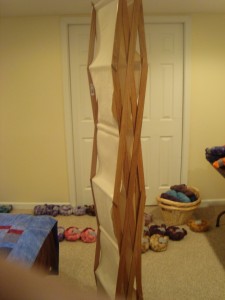
It folds up when it’s not in use, so it’s really easy to slip into the car when it’s time to go. We’re getting close!
Fri 6 Apr 2012
…makes Jack a dull boy, right?
Since most everyone seemed to be leaning toward play (and since I had some pretty strong leanings in that direction myself), I decided to try spinning the second half of the gradient as a short repeat yarn.
As instructed, I kept it simple. No overthinking…not even a bit. (Who me? Overthink? Never!)
I split the top along its full length, making 10 very narrow strips.
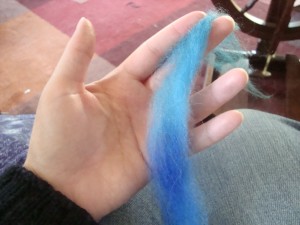
Then I spun them, one after the other until I ran out. (I was also careful to keep the cats out of the pile while I was spinning. This was critical, and proved to require more attention than I expected. Apparently lots of little strips of fiber = warm nest in the mind of a cat.)
I chain plied the singles like I did for the first skein, and ended up with about 2 yard lengths of each color (compared to about 20 yards per color in the previous skein). You can see the difference in the color distribution here:
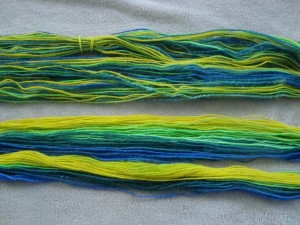
And the two skeins together:
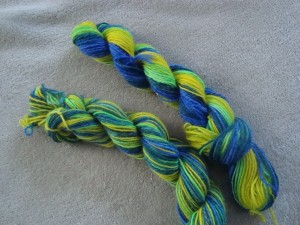
True to form, I like the long repeat version better in the skein, but I’m really not sure which I would prefer in the knitting.
I’d started out spinning this yarn expecting it to become a pair of socks, so I spun a (slightly heavy) sock weight. But then I was thinking about it, and I wasn’t sure that I wanted that long a gradient along the length of just one sock. That’s where the possibility generator kicked in and suggested that shorter repeats would be nice, so that there would just be a few rounds of each color in repeating stripes.
For a sock, I think I’d much prefer the shorter repeat version. I’d guess that there would be 3, maybe 4 rows per color, and then the colors will repeat every half inch or so, for the full length of the sock.
If I were to knit this into a shawl or a larger garment, then the long repeat version would look really good striped with a darker solid color. Of course, you could also alternate sections of long and short repeats to get all kinds of interesting combinations, too.
Because this is me, I no longer want to use this yarn for socks. My brain somehow manages to take a sharp left turn every time I sit down to think about knitting socks. Sweaters and shawls and bigger things are just much more exciting for some reason. (Also, I like my socks to match, which might be hard with this yarn now.)
Last night, I was having visions of a stranded colorwork bag, with the bright yarn worked on a dark blue background. But today, a mischievous little voice is suggesting that they would look very nice woven.
I said I didn’t overthink the spinning. I didn’t promise anything at all about the using of the yarn.
(Of course, all these ideas just mean more decisions, but that woven idea is pretty sticky. I think it might win.)
Wed 28 Mar 2012
The picture gods have smiled upon us, and I finally managed to get the right lighting conditions for good color photos of some of the new fibers I’ve been dyeing lately.
My color moods are always influenced by the season, so I suppose it’s no surprise that all I see are the colors of spring. There are happy daffodils dancing in the breeze:
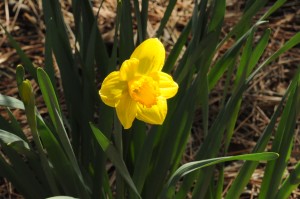
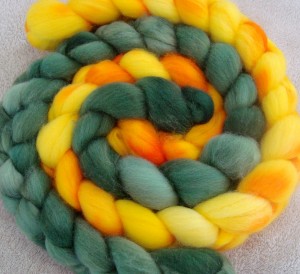
And then there are crocuses opening in the sun:
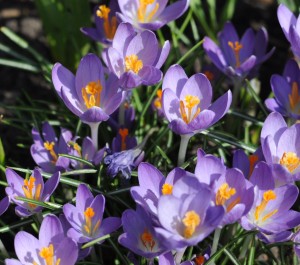
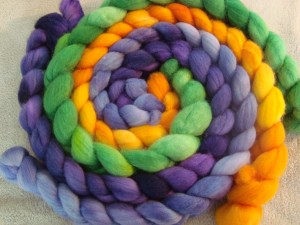
I also found some of the leftovers from last years’ garden in my dyepot.
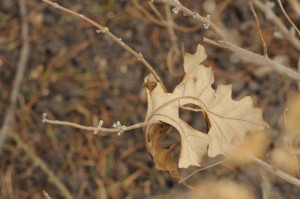
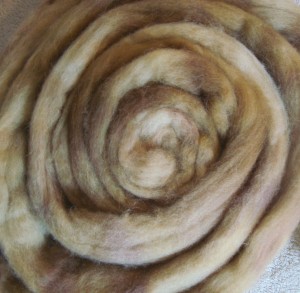
I dyed up some of the new rambouillet last week:
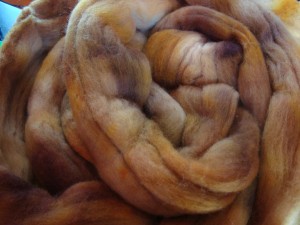
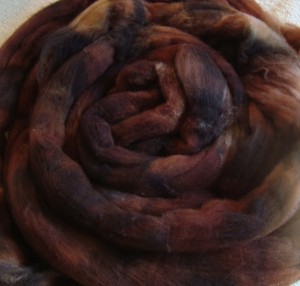
And this week, I have started moving out of the semisolids and into gradients, my next great adventure.
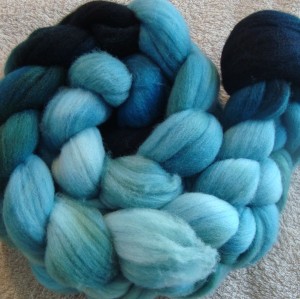
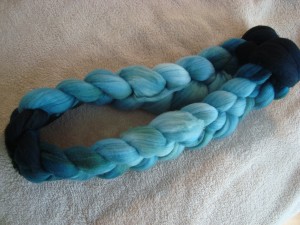
This fiber has 6 different concentrations of dye painted on it, going from pale all the way up to the most concentrated stock. I dyed this one with the fiber folded in quarters, because that’s what I had presoaked that day. Next time, I think I’ll fold the fiber in half instead, to get a longer repeat. This color looks beautiful with the dark walnut brown.
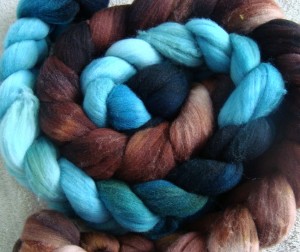
The names for the colors shown above:
Daffodil (Falkland) and Olive (Falkland)
Pale Crocus (Polwarth), Deep Crocus (Polwarth), Saffron (Polwarth), and Brilliant Green (BFL)
Faded Fall (Shetland)
Caramel (Rambouillet)
Walnut Brown (Rambouillet)
Spruce gradient (Rambouillet)
All of these fibers are available on Etsy.
Sun 25 Mar 2012
The striped shawl sweater has been slowly creeping slowly forward with the same knit-rip-knit pace. I’m past the striped section and have been working short rows to transition into the main body color. I started out decreasing one stitch for every three rows that I knit, which looked pretty good at first, but looked less good as the fabric grew. I worked short rows for both of the sleeves and half of the body before deciding that it looked a little too puffy.
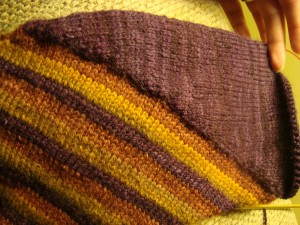
See how there’s a bump at the edge of the dark fabric? Well. It was bothering me. So I ripped it out, and reknit the short rows, decreasing one stitch for every 2 rows instead.
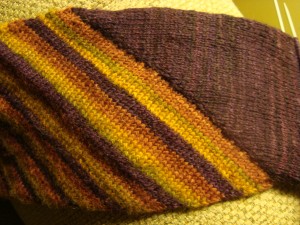
Isn’t that better?
I’ve since redone the short rows, and finished the main body section. I had to spin some more yarn to make it, but I am very happy with how it’s coming out.
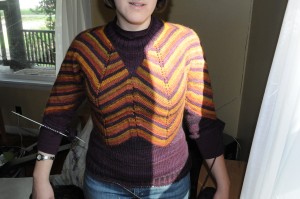
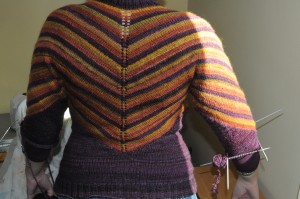
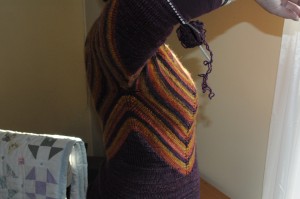
I am to the elbows on the sleeves and I am running on yarn fumes, so I’ll need to spin up another hundred yards or so to finish it off. I hadn’t counted on the short row decreases to add so much shaping, and I added a few of my own, which turns out to have been unnecessary. The final fit ended up a tiny bit tighter than I’d like, but I think it will loosen up with blocking and I don’t think it’s enough of a problem to rip back again. This project may finally be in the home stretch. All that’s left is finishing the sleeves, and then steeking the front to install the zipper. It’s getting close!
While I’ve been knitting the striped shawl, I’ve been keeping my spinning wheel busy finishing up the green for the fall colors sweater.
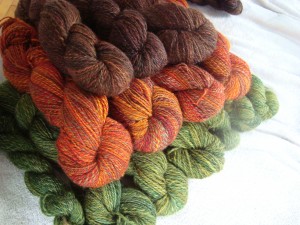
It’s all finished now, and will be ready to go as soon as I settle on a design. I’d like to say that it will be simple to make up for the last, but somehow I think that’s unlikely. (I’m still leaning toward the last design in this post, which will involve both steeking and a little bit of tailoring, and I’m thinking it likely that it will also have some rather experimental colorwork going on. Never a dull moment around here.)
Amazingly, that brought me to the end of what had seemed like a very long spinning queue, and suddenly it was time to start spinning the wool for Mike’s sweater, months earlier than I had planned. He’s a close friend of ours, and I think this may officially be the first big thing I’ve knit for someone outside of the family (mostly I knit just for Branden and I). We usually stay at Mike’s house over Christmas, and he was especially taken with Branden’s MacGyver sweater this year. He kept asking how long it took to make a sweater, from spinning the wool through to wearing it. I didn’t know, but I’ve decided to find out by spinning up the rest of the Shetland that I bought from that farm. Since Mike is also of an engineering bent and loved the MacGyver angle, I’ll also work in some of the leftover MacGyver yarn, probably as colorwork or stripes around the shoulders. For now, I’m spinning some wool from Harriet:
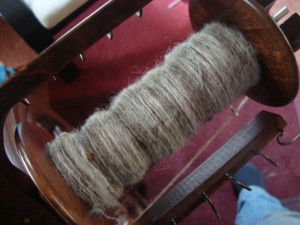
Doesn’t she have a lovely fleece? I liked it well enough in the roving, but it wasn’t until I started spinning it that I realized how beautifully heathered the gray is going to be. I have to admit that I have been struggling to resist the temptation to claim this wool as mine (as it was originally intended to be), but I am going to stick to the current plan. There will always be more fleeces, and I am getting to have a lot of sweaters!
One thing that has been very interesting about this set of projects is spinning from three fleeces from the same farm. You’d think they’d be pretty similar, given that they are three sheep fed and coated the same way, living in the same flock. The wool was presumably sheared by the same shearer and processed by the same mill. But the fleeces are not the same. As a reminder, MacGyver’s is the light gray wool in the sweater, and Magnolia’s is the dark brown.
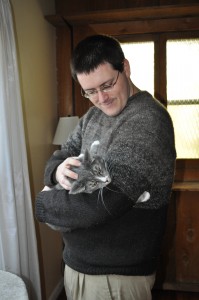
MacGyver’s wool was kind of downy, but had lots of heavier guard hairs in it. I tried picking them out as I went, but enough stayed in to make the sweater slightly prickly when worn on sensitive skin (fortunately, Branden doesn’t mind). As Branden has worn the sweater, the guard hairs have tended to poke out here and there, and we’ve been pulling them out over time. I’m not sure that it’s making much difference, but I like to think that the sweater is getting softer and softer with time. Either that, or we’re helping it to fall apart faster, but I’m sticking to the first interpretation. MacGyver’s was the first wool of the three that I spun, and it was full of little pills of short fiber, like the wool had been slightly tipped or there were second cuts in the shearing. I must admit that I was not looking forward to spinning three big bags of wool like that; pills in the spinning make me crazy. But the fiber was beautiful otherwise, and I loved the yarn, so I kept spinning.
Magnolia’s wool had none of the pills, and none of the guard hairs. It was a much thicker feeling fiber, very smooth and greasy, almost like alpaca. The pills must have been from MacGyver and not from the mill, since both Magnolia and Harriet’s fleeces are pill-free. Harriet’s fiber is different yet again. It is much lighter than Magnolia’s and very soft, Â more like the downy fleece in MacGyver’s wool. There aren’t many guard fibers at all, though there is a lot of hay. Harriet loved to wear her hay. I pull little bits out as I’m spinning, and I can’t help but imagine this sheep standing by her hay bale, munching away, pulling it down on top of her shoulders. Fortunately, most of it pops right out while I’m spinning, so it’s not a big deal, but it does amuse me to think of how this sheep must have always been wearing her food.
While I knit one sweater and spin toward the next, I’ve also been taking advantage of the beautiful weather to get outside and comb some more of my Gulf Coast fleece from last year. It is slow going, preparing a whole fleece by hand. I spun up most of what I had combed at Christmas to give to a friend, and I’ve only done a few ounces since then. It will be quite a while before I work my way through the whole 2.5 lbs, but it is very satisfying to see my bag fill up with these airy little puffs of fiber.
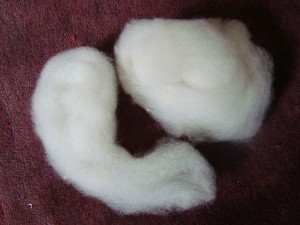
So there we have it. Handspun wool in all its stages. (Now all I need is a sheep.)
Wed 21 Mar 2012
One of the reasons for doing a fiber festival this year was to see how the business side of DesigKnit would scale. It’s an experiment, really; designed to help us identify and work through the sticky spots that are sure to crop up as things get bigger. (It’s always easier to work your way through the hurdles in a controlled experiment than it is when you’re doing things under pressure or on the fly.)
Fortunately, the first part is easy. I have no trouble at all thinking up more colorways. In fact, even with increased production I am still not even scratching the surface of things I want to explore. Everything I do suggests 5 more things to try. No problems there.
We’ve had a few jumps and starts with sourcing larger amounts of fiber. My staple products were no problem, since I just worked with my usual vendor and made a bigger order. We worked out a deal that made both of us very happy, and that was that.
The trouble came in when working with new vendors. I mentioned earlier that I wanted to start stocking Targhee and Rambouillet. It turns out that the Targhee is back ordered for some unknown period of time (waiting for wool to come back from the mill is a very unpredictable thing), so that’s on hold for now, pending further notice. The Rambouillet was in stock, and I was excited about buying directly from a small farmer, but she abruptly stopped returning my emails as soon as I asked about wholesale prices. I don’t know why, and it’s doubly unfortunate since I would have considered paying retail prices for the fiber, but there you have it. Sometimes things don’t go as planned.
This led me off on a quest to find more Rambouillet, at a reasonable price. I didn’t find another farmer, but I found someone that sells large quantities of commercial top. We had to really bite the bullet to pay for three times as much fiber as I’d have liked to order (30 lbs is a lot of fiber!), but we will be all set with Rambouillet for the forseeable future. This is a much more commercial prep, with a little less of the “sheep” left in the fiber. The other was clean and well processed, but it felt a lot closer to wool the way it comes off of the sheep than the more heavily processed version. If you’ve ever bought top at a sheep festival compared to a commercial prep, you know what I mean. (If you haven’t, get thee to a sheep festival to see the difference!) The new fiber is not as spongy as the mill-processed top, but because of that it drafts much, much more smoothly. Honestly, I like spinning it better than the other, though I always have a guilty preference for highly processed top, because it is so smooth to spin. It’s a beautiful fiber, and I’m excited to have it.
So we have the fiber and the dyeing worked out, but we just can’t seem to work our way around the pictures. Getting color accuracy in photos is notoriously difficult, and it seems that I tend to dye colors that are particularly hard to capture. Branden has been patiently clicking away, taking sometimes hundreds of photos with different settings before he gets one that works, but we still haven’t narrowed down the important variables. We think we have it with one batch, but then the same changes just don’t work on the next, and we end up starting all over again.
This has been a problem for a long time, but it wasn’t too bad when I was only producing a handful of colors at a time. It takes longer to take good photos than it does to dye the fiber, but we both like a challenge and we felt it was worthwhile. Now, though, I am making up to 20 colors in a single dye day, and the photography just can’t keep up. We have tried everything we can think of; changing the lighting, using different white cards and white balance settings, tweaking and adjusting every setting on our manual DSLR cameras. We started taking the photos in RAW format and trying to tweak them manually, but we’re not yet very good with the software and it takes forever to get right. (I am also terribly impatient with that part of the process: just thinking about it makes me break out in hives.)
Needless to say, we’ve ended up with quite a backlog of colors waiting to be photographed. After spending a good 6 or so hours of limited weekend time every weekend for weeks on end, we’re both pretty frustrated. Clearly, this is something that still needs work.
So, in an effort to keep things moving along, we’re going to try to take pictures of just a small subset of fibers for posting on Etsy and the blog. I had wanted to give the blog first go at the new colors that I’m making, but there is just no practical way to make that happen until we figure out this camera thing. Unfortunately, no pictures also means that I have no record of the colors that I’m making, and it changes the bookkeeping side of things, but for now I think that’s just how it has to be.
We will try to post photos of as many things as we can, but I’m not sure yet exactly how that’s going to work out. It would be easier if I wanted to just settle into a few standard colorways, but that takes the fun and the experimentation out of dyeing for me, so we’re going to have to find a way to make it work with more varieties.
Not posting all of the fibers has been a hard decision for me to make, because I hate secret projects. One of the promises that I made myself at the beginning of this little business venture was that I wouldn’t do anything that I couldn’t blog about. (That’s particularly important with patterns, since it dictates a lot about places you can and can’t publish.) Blogging is the first thing I want to do when I make a new set of colors or think up a design, and it blocks my process when I can’t talk about the things that I’m working on and excited about. It also makes for really boring blogging, and long silences.
So, we’re still working on that part. The good news is that I do still like to dye, and I don’t think I’ll ever run out of colors to try. I’ve been dragging my feet over the past few weeks, not wanting to dye anything new until we had photos of the old colors, but I really need to ramp it up in the next few weeks to get ready for the show. In the meantime, we’re trying to figure out how to smooth over or get around the other bumps in the road, trying to find a way to scale this process in a positive way.
For now, I need to go plan out the next dye session; there are so many more colors to make!
Fri 24 Feb 2012
I am yet again building up a list of small things going on behind the scenes that never quite make it to the blog. I think it is time for a catch up post.
Item the first:
I joined a new spinning group last month, and they have monthly workshops. I wasn’t terribly excited about the January meeting, because I’ve never been at all interested in needle felting. But I’ve found that one of the best things about being part of a group is trying things you wouldn’t otherwise do, so I went anyway. And I have to say I was pleasantly surprised. The poke-poke-poking went a lot faster than I had thought it would, and in the right frame of mind it’s even kind of relaxing. And, I really like the results:
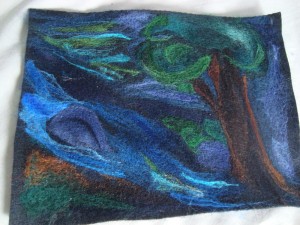
I doubt that I’m going to convert instantly to a needle-felting junkie, but it was just the right thing for my recover-from-interview  days last week. So, I started a flower.
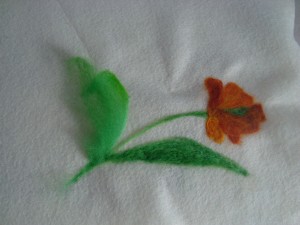
The nice thing about needle felting is that it finally gives me something to do with all the bits and pieces that I pull of of my fiber when I’m braiding it for the shop. There are always a few little pulls here and there, and the ends usually get a little felted, so I end up with a small handful of fiber from almost every colorway I make. I’ve been putting them aside as too good to throw out, and now I have quite a fun palette.
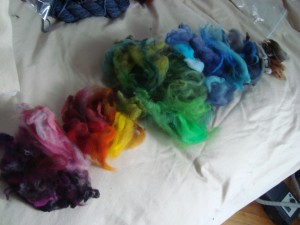
Moral of this story: Never assume that you are immune to any fiber craft, no matter how improbable it seems. (At least not if you’re me.)
Item the second:
The striped shawl sweater is now behaving beautifully. There were an awful lot of big bumps getting onto this road, but now that I’m on it I think it’s going to be much smoother. The points in the front are falling exactly where I expected them to:
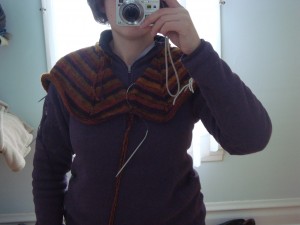
And the back is also laying nicely now.
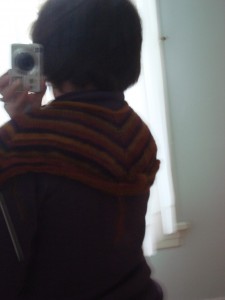
I’m not quite to the arm split yet, but if we get there without any more bumps in the road, then I think we’re home free.
Item the third:
I also finished spinning up the first “extra” skein of yarn for the main body of this project. I wasn’t sure how it would turn out, considering that I’d dyed the two batches of wool over 2 years apart.
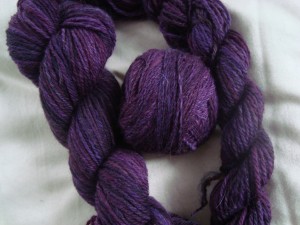
The ball in the middle is the old skein. The two on the sides are the new. I think that’s a pretty good match, don’t you?
I’m hesitant to attribute that to anything other than dumb luck, but I am pretty thrilled that I managed to get more of the same colorway after all this time.
Item the fourth:
Since I have now fully accepted that the striped shawl sweater is in fact going to be a sweater and not a shawl, that means that I have no good excuse not to just finish the shawl and be done with it. I sat down with my stitch dictionaries, and almost immediately stumbled across the perfect edging in Knitted Lace of Estonia. I spent days and days looking for border patterns last time I was working on this shawl, and this time it just fell into my hands. I’m taking that as a sign.
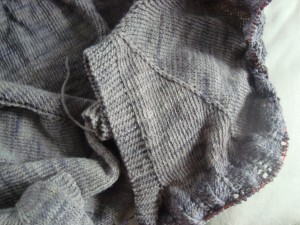
Unfortunately, each row takes about 45 minutes to knit, so it’s not exactly flying off the needles. Still, it’s making progress, and it should be ready to bind off soon. Yay for finished objects!
Item the fifth:
I was in need of a project that felt like it was going somewhere, so I whipped up a little instant gratification last weekend. I had just finished spinning up my sample of the Rambouillet top, with the aim of making a hat for Branden. It really doesn’t take long to knit a hat in worsted yarn, especially when it’s just a simple, simple hat with a little short row shaping.
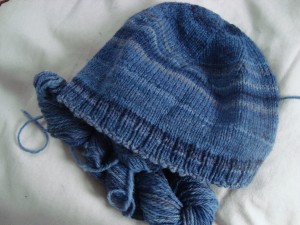
I was hoping for a modeled shot, but that’s why it hasn’t been blogged yet, and I bet you can imagine what a hat looks like on a head. I tried taking photos in the mirror, but it’s amazing how hard it is to take a picture of your own head.
I love how the colors came out on this one. They’re a tad bit greyer than they look in the photo, but I love those stripes. I ended up with about 220 yards of yarn, and the hat took almost precisely half. There should be enough left for a pair of handwarmers, too.
Item the sixth:
I have finished the first sleeve of the lace ribs sweater. I have no idea why this is taking me so long, besides the fact that I just don’t love knitting pieces flat. I usually do everything in the round, but the lace needs seams to keep its structure, and so it must be knit flat. Somehow, this is just never the project that I pick up first.
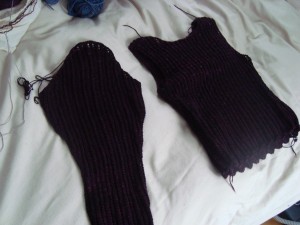
The good news is that the charts and instructions are almost done, so as long as the sleeve is actually the right size and shape after blocking, I should be almost done with the pattern.
The last item isn’t really an item, so much as it is something on my “must-catch-up” list. If I don’t get this fiber wrangled soon, it’s going to eat my office.
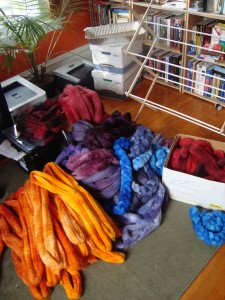
That is something like 48 braids worth of fiber. Those bankers boxes you see in the background? Also fiber, stuffed full to bursting. The stuff on the floor is waiting for photos and Etsy posting. Branden’s robotics team shipped their robot on Tuesday, so hopefully it will be a little easier to find time to take photos soon. (It’s kind of hard to find daylight picture time when he’s gone 4 days a week from morning until after I’m in bed, and at least half of the day on Saturday.)
Yellows and browns are next, but I’m holding off until after this batch is done. I don’t want to get swallowed up by the stash!
We’re almost all the way to a full rainbow now. I can’t wait to put them all together and see the full spectrum. And then, when the semisolids are done, I get to go back to the variegated colorways. So. many. ideas!
Sat 18 Feb 2012
Dyeing is the perfect winter sport. Just when I can’t stand the gray, I go into my basement and make this:
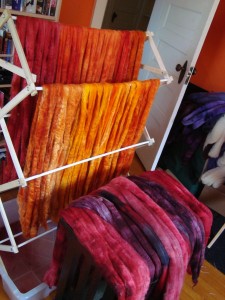
Yesterday’s colors were red and orange. Hopefully we’ll have real pictures soon, along with the purple and green. Let there be color!
Thu 2 Feb 2012
Between our recent photo-taking difficulties and just general laziness, I have gotten terribly behind in the posting of new fibers for the shop. There are two dye days ready to post, and another just waiting for photos (we’ll look at that one later).
I’m still working on beefing up my selection of semisolids, with an eye to producing colors that will go with more variegated colorways that I’ve been dreaming up and will hopefully get to dye soon. On the first dye day, I was trying to broaden my range of colors available in the Etsy shop. On the second day, I realized that I’m now dyeing for a show, and I need a wider selection of each color, and possibly even multiple copies of each one. The second dye day was all about blue, so you’ll see a lot of it here.
Since there’s a lot to cover, let’s go by breed, shall we?
I’ve had a few pounds of Shetland hanging around in my dyeing stock, waiting patiently for its turn to be dyed.
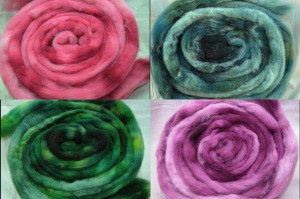
BFL is always a staple around here, so there’s quite a bit of that, too.

Along with a little Polwarth (because what’s a dye day without Polwarth?)
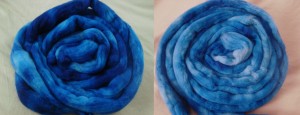
You can really see how much the camera has been acting up in those photos; the background fabric is the same for both, but it looks completely different. At least the fiber colors are finally right!
And finally, we have a couple of guest stars for the day. As I mentioned in my last post, I’m still working on sourcing more Targhee and Rambouillet fibers; the tradeoff of working with small farms is that they don’t have as steady an inventory as a bigger operation. The plus side is that they do have beautiful fibers:

That’s the Targhee, dyed up as semisolids. And then there’s the Rambouillet:

You can’t see it from the pictures, but the Rambouillet top is actually a lot thinner than the other fibers. When I braided it up, it was almost 3 times as long as the others! Since it’s such a crimpy fiber, the thinner preparation really cuts down on the amount of predrafting that’s necessary (and it makes you feel like you’re getting a lot more than 4 oz!)
And now for the pairings:
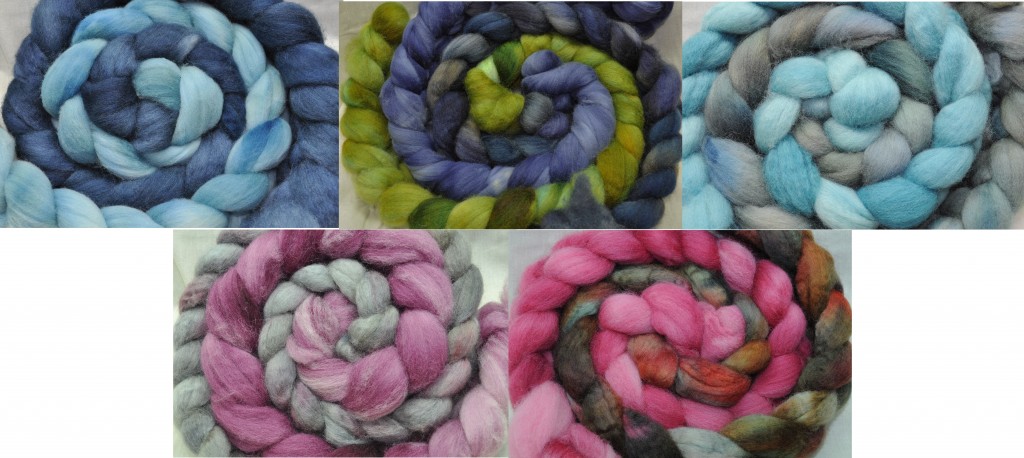
Top row:
Pale Teal Targhee and Slate Blue BFL
Spring Greens BFL, Denim Targhee, and Grey-Blue semisolid BFL
Pale Teal Targhee and Storm Greens Falkland
Bottom row:
Pale Purple Shetland and Silver Rose BFL
Cotton Candy Shetland and Cocoa Berry BFL
As always, all the colors are now available in the shop, and I have a whole batch of greens just waiting for pictures. More soon!
Wed 30 Nov 2011
I’m afraid I’ve been knitting and spinning more than I have been posting lately, and I am developing quite a backlog of things to tell you about. For tonight, I think we’re a bit overdue for an update on the Fall Colors sweater, yes?
Over the past couple of weeks, I have been turning this:
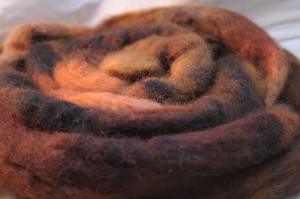
into this:
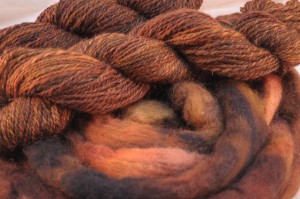
(Actually, I’ve finished all the brown, but I really liked the comparison of the original top and the final yarn.)
The Finn didn’t get at all sticky this time, and it has been absolutely beautiful to spin. It’s a nice fiber even when I get it wrong, but when I get it right, it’s amazing.
The colors also came out really well on this one. They ended up a little lighter than I expected in the final yarn, so I may have to overdye a bit at the end to darken it up a bit. I was expecting to get the balance shown in the first color; mostly dark with a few light spots for contrast, but it came out just the opposite. I’m working to come up with a design modification that will let me get around overdyeing it, though, because I really, really want to keep all those subtle color changes in the yarn. (I have been agonizing over this enough that there have even been suggestions that I should just dye up more fiber in a darker color and keep this yarn for something else. It is a tempting offer, but I think I can make it work.)
When I dyed this fiber, I knew that I wanted to match the original red-orange colorway. I used the same brown dyes that I had used to accent the red-orange fiber, and then added in a tiny bit of the orange and even a little bit of green. You can’t see it too well in the photo above, but it’s there. I was surprised to see how much that came across in the yarn. There are sections where one ply is a deep, olive green instead of brown, and a couple of spots where it lightens up almost to orange. I’m hoping that will help to tie the colorways even closer together in the final piece.
I used the same strategy for the green, dyeing it with the orange as a base dye and adding teal to make the green I wanted. Then, I threw in some dabs of brown here and there, and a slightly lighter green to brighten things up.
So far, I think they go really well together.
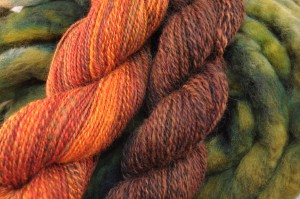
I started spinning the green at the Spinning Guild meeting on Monday. I can’t wait to see how it comes out!
Sun 20 Nov 2011
I must go down to the seas again, to the lonely sea and the sky,
And all I ask is a tall ship and a star to steer her by,
And the wheel’s kick and the wind’s song and the white sail’s shaking,
And a gray mist on the sea’s face, and a grey dawn breaking.
I must go down to the seas again, for the call of the running tide
Is a wild call and a clear call that may not be denied;
And all I ask is a windy day with the white clouds flying,
And the flung spray and the blown spume, and the sea-gulls crying.
I must go down to the seas again, to the vagrant gypsy life,
To the gull’s way and the whale’s way, where the wind’s like a whetted knife;
And all I ask is a merry yarn from a laughing fellow-rover,
And quiet sleep and a sweet dream when the long trick’s over.
-John Masefield
I grew up in Plymouth, MA. Land of the pilgrims, steps from the sea. The Atlantic ocean is a daily part of life there; you really can’t go anywhere without catching a glimpse of it here and there through the trees. The north Atlantic is a moody sea, a body of water with its own strong personality. If you live near it long enough, it becomes a part of your life, a character in your story.
When we left New England, I couldn’t imagine not living near an ocean. With the exception of a summer in upstate New York, I had spent most of my life not 5 miles from the coast. You get used to the smell and the sound; the salt air wafting in on a morning mist, people flocking to the shore in the summer. The off season has a different feel – then you see the hard, unyielding, and rocky side of the coast, the cold, biting wind, and the beautiful rolling waves of a winter storm. The passion and the fury of an untamed sea. Calm or angry, the ocean is unchanging, and yet never the same.
Linda and I were emailing a while ago, and she mentioned that she had seen a particular green in the ocean while out on a boating trip but hadn’t been able to capture it with her camera. She didn’t need to; with a bit of description, I knew which color she meant. I thought I might even have some photos of it myself, but we bought our first digital camera after leaving Massachusetts, so I have almost no pictures, except the ones held in my mind. Still, it got me thinking of all the colors and moods of the ocean, and of ways I might try to capture those colors on fiber.
Last weekend, I gave it my first attempt, on BFL and Falkland.
There is the color of the sea at sunset, waves lapping on a sandy shore. In the summer, sunset is the time that the locals head to the public beaches; the sand is less crowded and parking is free. As the sky turns gold, the water takes on a greenish hue.
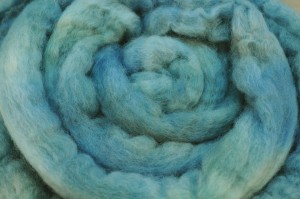
In the winter, you’ll see those same greens mixed with grey on a cloudy day.
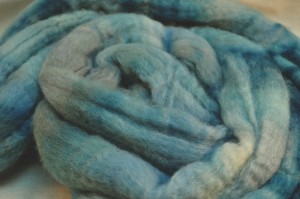
In a storm, the colors deepen and mix with a hint of brown.
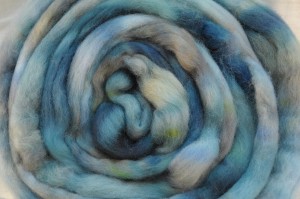
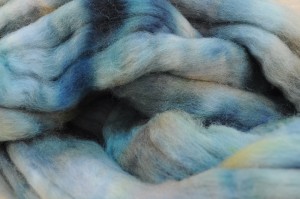
The summer sea is a different creature; laughing and throwing waves lightly on the shore. Whitecaps dance across a sapphire blue, and children play in the foam. For this color, I made sure to leave long repeats of pure white so that those whitecaps will show.
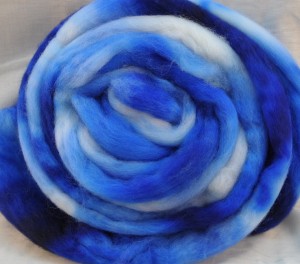
I can almost hear the waves.
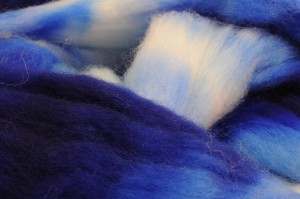
On calm days, waves rise up to touch a cloudless blue, and the water can almost take on the same color as the sky. The horizon disappears, and all there is is a vast expanse of blue.
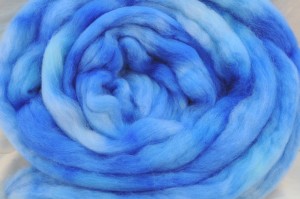
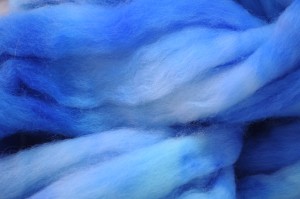
Throw in a little grey, and you have the moodier color of a winter ocean. The water just looks icy cold, stretching out forever beneath a pale grey sky.
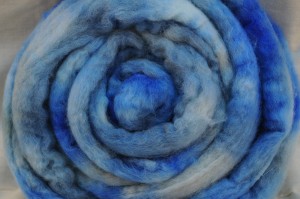
I’m not sure I found the green that Linda was talking about; the green of a sea churned into foam by the passing motor of a boat. I know which one it is, and I don’t see it here. There are an infinity of colors to be captured, and I think I missed that one. I know it’s in the dyepots somewhere, but I’ll need to sample more to find it.
I won’t mind coming back to these colors again, though. They do make me ache for the ocean, but it’s hard to resist the pull of those blues. I could wrap myself in any one of them.
It was really interesting to see the Falkland next to the BFL. BFL has a shiny, high-luster appearance, like silk. The Falkland is a more matte look, fluffy and soft, almost like a chenille or a velvet by comparison. We couldn’t quite capture the difference in a photo, but this one comes pretty close:
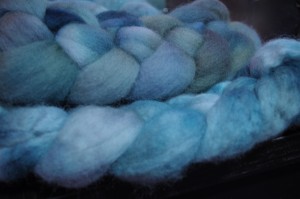
That’s Falkland on top, and BFL on the bottom. The lighting isn’t great, but you can see that there’s more shine from the one on the bottom. Personally, I’m in love with the squoosh of the Falkland at the moment, but that silky look is pretty nice, too.
A couple of people have mentioned the idea of sets of colors for the shop. I like to let customers choose their own mixes, but I usually dye several colorways at once, with the idea that they will kind of go together. I have a core set of dyes that I really like to use, and so those colors show up again and again in different mixtures and on different fibers. I’ve added links to the Etsy posts for colorways that I think will coordinate, and thought I’d show a few photos of these colors next to each other, to give you some ideas of how to mix your own sets if you like.
There’s the Storm Green and Winter Greys:
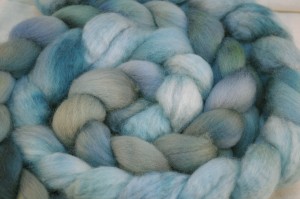
And the Sea Green and Winter Greys together:
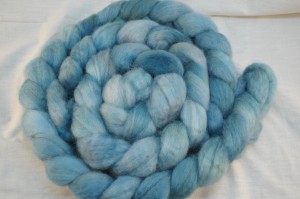
These two are so similar that it’s really hard to tell that there are two, but that’s the Winter Greys on the inside. If you plied the two colors together, you’d definitely get a single colorway. If you spun them separately, you’d get a subtly different pair.
Whitecaps and Sea and Sky are the same basic dyes in different saturations, so they could easily be spun together:
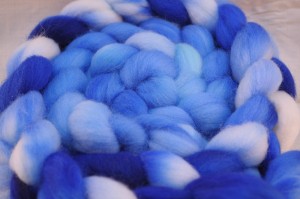
There are so many combinations, and I’d mix colors differently depending on the kind of yarn I wanted in the end. If you’re ever considering two items in the shop and want a photo of the two together like this, let me know.
We also took pictures of my favorite fall colors roving today. It got left out last time for bad behavior because we just could. not. get the colors right…the reds were too intense for the camera. Today, we used a different lighting setup, and Branden managed to capture it.
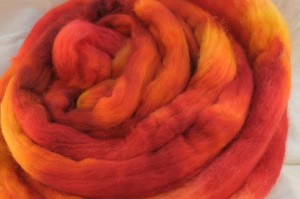
Those fiery reds pair really, really well with the Fallow Fields roving that I dyed on the same day:
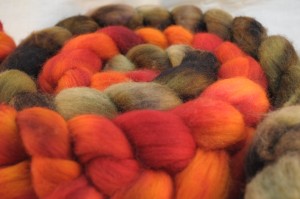
That’s it for my latest dye day. All the fibers shown are over on Etsy.
I received a box the other day containing these,
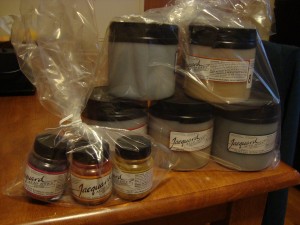
so there’s bound to be more color coming soon. I’ve even moved up to 8 oz jars for my favorite dyes now…somehow that feels like entering the big time.






























































